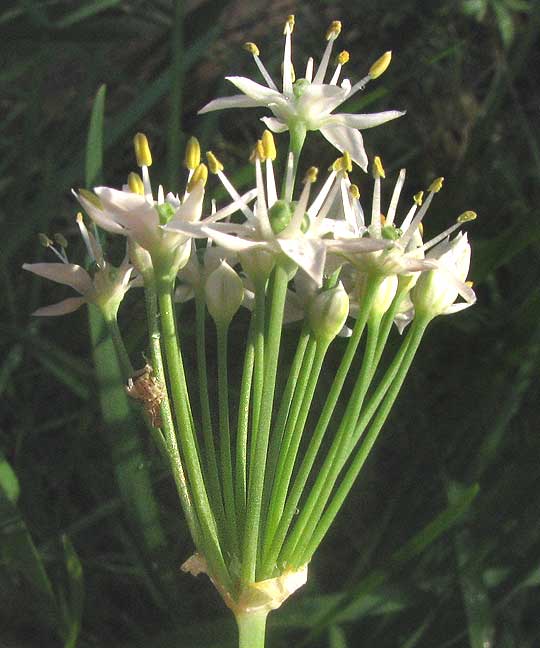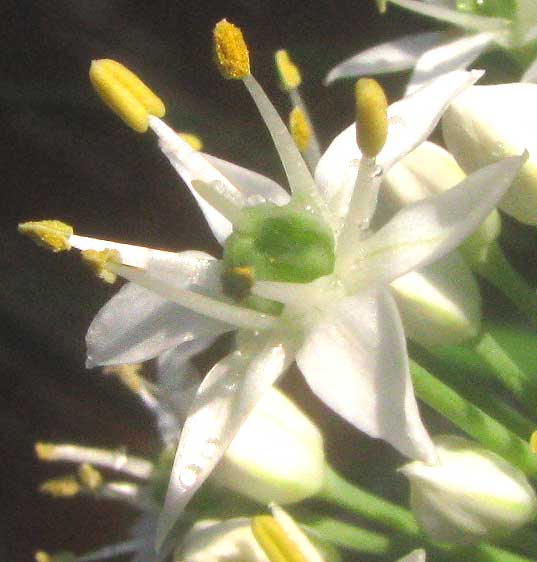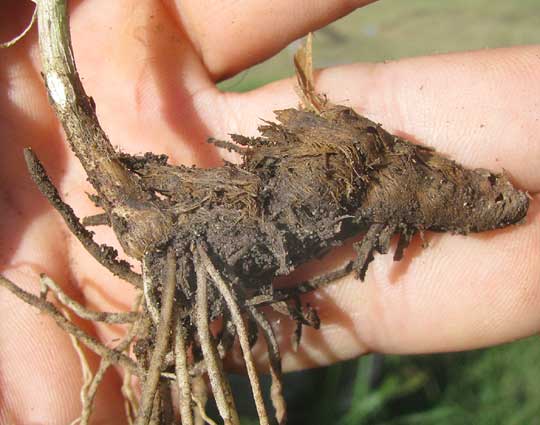Excerpts from Jim Conrad's
Naturalist Newsletter

from the September 15, 2013 Newsletter issued from the Frio Canyon Nature Education Center in the valley of the Dry Frio River in northern Uvalde County, southwestern Texas, on the southern border of the Edwards Plateau; elevation ~1750m (~5750 ft); N29.62°, W99.86°; USA
GARLIC CHIVES
When I arrived here a year ago, in the small flowerbed behind the red cabin in which I spent the winter, there was a dense clump of flat, grasslike leaves. When I dug into the cluster preparing to transplant it to where there was more sunlight, the entire plant smelled strongly of onion. However, when I began digging, instead of bulbs I found rhizomes -- dark-brown, scaly, underground stems. Everyone knows that onion plants arise from bulbs, so apparently this wasn't an onion. Therefore, what onion-smelling, onion-looking plant produces such rhizomes? I couldn't figure it out, so I transplanted the rhizomes and waited for the flowers. A year later, now the plants finally are flowering, as you can see above.
They look like onion flowers, but onions don't arise from rhizomes, right? A side view of a flower cluster, or inflorescence, shows a classic umbel, also typical of onion species, shown below:

Below, a flower close-up shows six white perianth segments below six stamens with narrow, white filaments, arising from the base of a three-celled, superior ovary -- all exactly as with onion flowers:

A view from below the flowers showing that the perianth segments are not the least joined with one another at their bases -- which they shouldn't if they're onion flowers -- is shown below:

So, here the flowers are screaming at us that they are onion flowers, but onions are members of the genus Allium of the Lily Family, and even the Flora of North America says that members of the genus Allum are perennial herbs that arise from "tunicate bulbs" -- tunicate referring to the loose membrane or "skin" around onion bulb.
Though I definitely remembered digging up rhizomes last year, I decided to dig up a plant this year and look again. Below, you can see what I found:

That's definitely a scaly rhizome, but look at the base of the onion plant stem coming down from the upper left of the picture. It's slightly bulged and rounded at the base, and that rounded, bulging zone is a genuine small bulb attached to a genuine rhizome. I simply didn't know that onion plants could arise from bulbs attached to rhizomes.
This is ALLIUM TUBEROSUM, variously known as Garlic Chives, Chinese Chives, Oriental Garlic, Chinese Leek, and Kow Choi. It's native to southeastern Asia but escapes into the wild in many countries, including here and there in the US.
Garlic Chives is an important ingredient in many Asian dishes. On the species' Wikipedia page I read that "They are a common ingredient in Chinese jiaozi dumplings and the Japanese and Korean equivalents. The flowers may also be used as a spice. In Vietnam, the leaves of garlic chives are cut up into short pieces and used as the only vegetable in a broth with sliced pork kidneys."